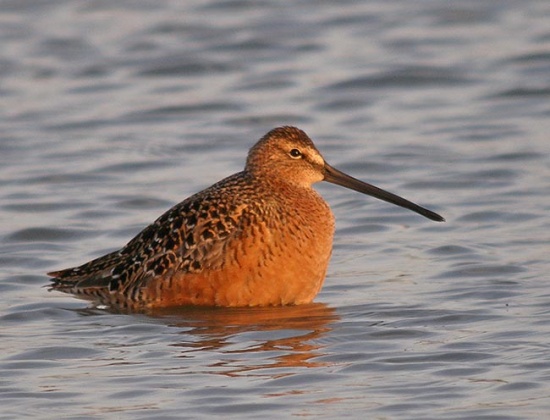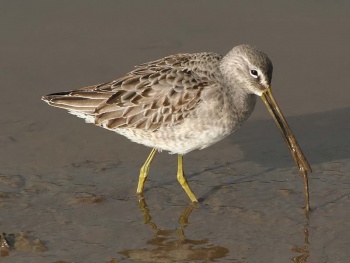(Attempt to disguise some copied text. Breeding & Flight photos. Misc info added. References) |
(→External Links: 1 added to GSChecked) |
||
| (19 intermediate revisions by 4 users not shown) | |||
| Line 1: | Line 1: | ||
| − | [[Image: | + | [[Image:1568short billed dowitchers breedP5067752.jpg|thumb|550px|right|Breeding Plumage<br >Photo © by {{user|Neil|Neil}}<br />Palo Alto, [[California]], May 2006]] |
;[[:Category:Limnodromus|Limnodromus]] scolopaceus | ;[[:Category:Limnodromus|Limnodromus]] scolopaceus | ||
==Identification== | ==Identification== | ||
| − | + | [[Image:Long-billed_Dowitcher.jpg|thumb|350px|right|Non-breeding<br />Photo © by {{user|postcardcv|postcardcv}}<br /> Hayle, [[Cornwall]], [[UK]], February 2006]] | |
| + | 24–30 cm (9½-11¾ in)<br /> | ||
*Yellowish-green legs | *Yellowish-green legs | ||
*Long straight dark bill, slightly distally de-curved | *Long straight dark bill, slightly distally de-curved | ||
| − | *Tail has a black and white barred pattern | + | *Tail has a black and white barred pattern with narrow white bars and broader dark bars. |
| − | *Prominent | + | *Prominent [[Topography#Heads|supercilium]] |
| − | *Noticeable white trailing edge to wing | + | *Noticeable white wedge up the back and trailing edge to wing<br /> |
| − | '''Breeding''' | + | '''Breeding''' |
| − | |||
*Dark brown upperparts | *Dark brown upperparts | ||
| − | * | + | *Salmon-red underparts including undertail coverts |
| − | *Spotted throat | + | *Spotted throat |
| − | *Barred flanks | + | *Barred sides of breast and flanks |
'''Winter'''<br /> | '''Winter'''<br /> | ||
*Mostly grey | *Mostly grey | ||
*White lower belly | *White lower belly | ||
| + | '''Juvenile'''<br /> | ||
| + | Fine rusty fringing to mantle lacking internal markings on tertials. | ||
| + | ====Similar species==== | ||
| + | [[File:Long-billed_Dowitcher_Flight_STEF.jpg|thumb|350px|right|<br />Photo © by {{user|STEFFRO1|Steffen Roberts}}<br />[[Huntington Beach State Park]]<br />[[South Carolina]], [[USA]], 15 May 2021]] | ||
| + | In non-breeding plumage very similar to [[Short-billed Dowitcher]]. Breeding Long-billed has more extensively colored underparts and has barring on the side of the breast while Short-billed is spotted on the breast. Juvenile plumage very different with Short-billed having much broader more extensive internal markings on mantle and tertials than Long-billed. At all seasons, best distinguished by voice. | ||
==Distribution== | ==Distribution== | ||
| Line 23: | Line 28: | ||
Regular vagrant to [[Europe]], particularly [[Britain]] and [[Ireland]]. | Regular vagrant to [[Europe]], particularly [[Britain]] and [[Ireland]]. | ||
==Taxonomy== | ==Taxonomy== | ||
| − | + | This is a [[Dictionary_M-O#M|monotypic]] species<sup>[[#References|[1]]]</sup>. | |
| − | |||
==Habitat== | ==Habitat== | ||
Although preferring fresh water habitats, they can also be seen in estuaries, mud flats, saltwater wetlands, reservoirs, and sewer ponds. | Although preferring fresh water habitats, they can also be seen in estuaries, mud flats, saltwater wetlands, reservoirs, and sewer ponds. | ||
==Behaviour== | ==Behaviour== | ||
| + | ====Actions==== | ||
| + | Probes with an up-and-down action often described as like a sewing machine. | ||
====Breeding==== | ====Breeding==== | ||
They nest on the ground, usually near water. | They nest on the ground, usually near water. | ||
====Diet==== | ====Diet==== | ||
Diet mainly consists of small crustaceans, molluscs, insects and marine worms, but includes some plant material as well. They forage by probing in shallow water or on wet mud. | Diet mainly consists of small crustaceans, molluscs, insects and marine worms, but includes some plant material as well. They forage by probing in shallow water or on wet mud. | ||
| + | ====Vocalisation==== | ||
| + | Common call is a squeaky high pitched note or series of notes, recalling [[Sanderling]]. | ||
| + | ====Movements==== | ||
| + | Migratory. Southward migration through North America usually later than [[Short-billed Dowitcher]]; winters on West Coast, southern [[USA]] and [[Mexico]]. | ||
| + | |||
==References== | ==References== | ||
| − | #{{Ref- | + | #{{Ref-Clements6thAug19}}#Chandler, R. (2009). Shorebirds of North America, Europe, and Asia: A photographic guide. Princeton Univ. Press. |
| − | # | + | #Takekawa, J. Y. and N. D. Warnock (2000). Long-billed Dowitcher (''Limnodromus scolopaceus''), version 2.0. In The Birds of North America (A. F. Poole and F. B. Gill, Editors). Cornell Lab of Ornithology, Ithaca, NY, USA. https://doi.org/10.2173/bna.493 |
| − | # | + | #Van Gils, J., Wiersma, P. & Kirwan, G.M. (2020). Long-billed Dowitcher (''Limnodromus scolopaceus''). In: del Hoyo, J., Elliott, A., Sargatal, J., Christie, D.A. & de Juana, E. (eds.). Handbook of the Birds of the World Alive. Lynx Edicions, Barcelona. (retrieved from https://www.hbw.com/node/53886 on 21 February 2020). |
| + | #Wikipedia contributors. (2020, January 18). Long-billed dowitcher. In Wikipedia, The Free Encyclopedia. Retrieved 10:31, February 21, 2020, from https://en.wikipedia.org/w/index.php?title=Long-billed_dowitcher&oldid=936406427 | ||
| + | #{{Ref-Grantetal99}}#BirdForum Member observations | ||
{{ref}} | {{ref}} | ||
| + | |||
==External Links== | ==External Links== | ||
| − | {{GSearch|Limnodromus | + | {{GSearch|"Limnodromus scolopaceus" {{!}} "Long-billed Dowitcher"}} |
| + | {{GS-checked}}1 | ||
| + | <br /> | ||
| + | <br /> | ||
[[Category:Birds]][[Category:Limnodromus]] | [[Category:Birds]][[Category:Limnodromus]] | ||
Latest revision as of 20:38, 27 January 2024
- Limnodromus scolopaceus
Identification
24–30 cm (9½-11¾ in)
- Yellowish-green legs
- Long straight dark bill, slightly distally de-curved
- Tail has a black and white barred pattern with narrow white bars and broader dark bars.
- Prominent supercilium
- Noticeable white wedge up the back and trailing edge to wing
Breeding
- Dark brown upperparts
- Salmon-red underparts including undertail coverts
- Spotted throat
- Barred sides of breast and flanks
Winter
- Mostly grey
- White lower belly
Juvenile
Fine rusty fringing to mantle lacking internal markings on tertials.
Similar species
In non-breeding plumage very similar to Short-billed Dowitcher. Breeding Long-billed has more extensively colored underparts and has barring on the side of the breast while Short-billed is spotted on the breast. Juvenile plumage very different with Short-billed having much broader more extensive internal markings on mantle and tertials than Long-billed. At all seasons, best distinguished by voice.
Distribution
Breeds in Siberia and Alaska; winters from southern U.S. to Panama.
Regular vagrant to Europe, particularly Britain and Ireland.
Taxonomy
This is a monotypic species[1].
Habitat
Although preferring fresh water habitats, they can also be seen in estuaries, mud flats, saltwater wetlands, reservoirs, and sewer ponds.
Behaviour
Actions
Probes with an up-and-down action often described as like a sewing machine.
Breeding
They nest on the ground, usually near water.
Diet
Diet mainly consists of small crustaceans, molluscs, insects and marine worms, but includes some plant material as well. They forage by probing in shallow water or on wet mud.
Vocalisation
Common call is a squeaky high pitched note or series of notes, recalling Sanderling.
Movements
Migratory. Southward migration through North America usually later than Short-billed Dowitcher; winters on West Coast, southern USA and Mexico.
References
- Clements, J. F., T. S. Schulenberg, M. J. Iliff, S. M. Billerman, T. A. Fredericks, B. L. Sullivan, and C. L. Wood. 2019. The eBird/Clements Checklist of Birds of the World: v2019. Downloaded from http://www.birds.cornell.edu/clementschecklist/download/
- Chandler, R. (2009). Shorebirds of North America, Europe, and Asia: A photographic guide. Princeton Univ. Press.
- Takekawa, J. Y. and N. D. Warnock (2000). Long-billed Dowitcher (Limnodromus scolopaceus), version 2.0. In The Birds of North America (A. F. Poole and F. B. Gill, Editors). Cornell Lab of Ornithology, Ithaca, NY, USA. https://doi.org/10.2173/bna.493
- Van Gils, J., Wiersma, P. & Kirwan, G.M. (2020). Long-billed Dowitcher (Limnodromus scolopaceus). In: del Hoyo, J., Elliott, A., Sargatal, J., Christie, D.A. & de Juana, E. (eds.). Handbook of the Birds of the World Alive. Lynx Edicions, Barcelona. (retrieved from https://www.hbw.com/node/53886 on 21 February 2020).
- Wikipedia contributors. (2020, January 18). Long-billed dowitcher. In Wikipedia, The Free Encyclopedia. Retrieved 10:31, February 21, 2020, from https://en.wikipedia.org/w/index.php?title=Long-billed_dowitcher&oldid=936406427
- Grant, P.J., K. Mullarney, L. Svensson, D. Zetterstrom (1999) Collins Bird Guide: The Most Complete Field Guide to the Birds of Britain and Europe. Harpercollins Pub Ltd ISBN 0 00 219728 6
- BirdForum Member observations
Recommended Citation
- BirdForum Opus contributors. (2024) Long-billed Dowitcher. In: BirdForum, the forum for wild birds and birding. Retrieved 8 May 2024 from https://www.birdforum.net/opus/Long-billed_Dowitcher
External Links
GSearch checked for 2020 platform.1






